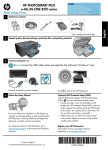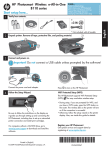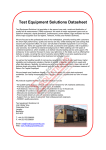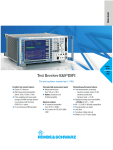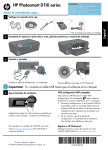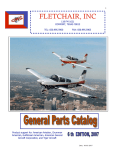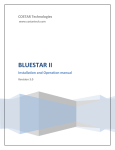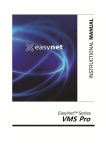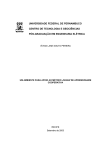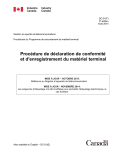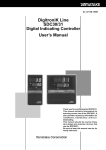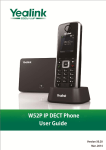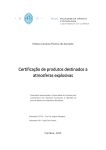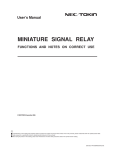Download UL TCB Program
Transcript
RTCB General Information for Suppliers – Issue 1.0 Issued: 2009-04-28 Revised: UL Radio and Telecommunications Certification Body (RTCB) Programs GENERAL INFORMATION FOR SUPPLIERS PROGRAMS AND SCOPES OF ACCREDITATION: UL is accredited as a certification organization for the FCC TCB program, the Industry Canada Certification Body program and Singapore’s Infocomm Development Authority of Singapore (IDA) Certification Body Scheme. 1.1 FCC TELECOMMUNICATIONS CERTIFICATION BODY (TCB) PROGRAM 1.1.1 FCC – TCB Scope of Accreditation Scope A – Unlicensed Radio Frequency Devices A1 Low power transmitters operating on frequencies below 1 GHz (with the exception of spread-spectrum devices), emergency alert systems, unintentional radiators (e.g., personal computers and associated peripherals and TV Interface Devices) and consumer ISM devices subject to certification (e.g., microwave ovens, RF lighting and other consumer ISM devices) A2 Low power transmitters operating on frequencies above 1 GHz, with the exception of spread spectrum devices A3 Unlicensed Personal Communication Service (PCS) Devices A4 Unlicensed National Information Infrastructure (UNII) devices and low power transmitters using spread spectrum techniques Scope B – Licensed Radio Service Equipment B1 Personal Mobile Radio Services in 47 CFR Parts 22 (cellular), 24, 25, and 27 B2 General Mobile Radio Services in the following 47 CFR Parts 22 (non-cellular), 73, 74, 90, 95 and 97 B3 Maritime and Aviation Radio Services in 47 CFR Parts 80 and 87 B4 Microwave Radio Services in 47 CFR Parts 27, 74 and 101 Scope C – Telephone Terminal Equipment C1 Telephone terminal equipment in 47 CFR Part 68 1.1.2 FCC TCB Program Information For details regarding the FCC Telecommunications Certification Body Program go to the FCC TCB Website: For an overview of the program refer to the FCC “TCB PROGRAM ROLES AND RESPONSIBILITIES” which can be found at: http://www.fcc.gov/oet/ea/FCC-Overview-TCB-Program.pdf For details regarding the certification of terminal equipment refer to the publication “Equipment Authorization of Telephone Terminal Equipment” located at: www.fcc.gov/oet/ea/TCB-part-68-list.pdf. Additional information: TTE requirements and equipment authorization, and the role of the Administrative Council for Terminal Attachments (ACTA) can be found at www.part68.org. 1.2 1.2.1 INDUSTRY CANADA CERTIFICATION BODY PROGRAM Industry Canada Accreditation Scopes CAB Identifier: US0114 Scope A - All Radio Standards Specifications (RSS) in the Category I Equipment Standards List. , RSS - 112 Issue 1 ,RSS - 194 Issue 1 ,RSS - 287 Issue 1 1.2.2 Industry Canada Program Information Information relating to equipment certification in Canada can be found at: http://www.ic.gc.ca/eic/site/ceb-bhst.nsf/eng/h_tt00012.html Page 1 of 20 RTCB General Information for Suppliers – Issue 1.0 Issued: 2009-04-28 Revised: Information on wireless program can be found at the Industry Canada web page: http://www.ic.gc.ca/eic/site/ceb-bhst.nsf/eng/h_tt00010.html Information on the terminal attachment program can be found at the Industry Canada web page: http://www.ic.gc.ca/eic/site/ceb-bhst.nsf/eng/h_tt00013.html 1.3 INFOCOMM DEVELOPMENT AUTHORITY OF SINGAPORE (IDA) CERTIFICATION BODY SCHEME 1.3.1 IDA Scope of Designation APEC TEL MRA - Phase II; Six-character Identifier: US0065 IDA TS DLCN: Jul 2005 IDA TS PSTN: March 2007 IDA TS ISDN-BA: July 2005 IDA TS ISDN-PRA: July 2005 IDA TS PSTN: July 2005 IDA TS SRD: July 2005 Refer to the IDA website regarding the latest information. http://www.ida.gov.sg/Policies%20and%20Regulation/20060609145118.aspx 1.3.3 IDA Program Information Information on the IDA Certification Body Scheme can be found in the publication Scheme for Recognising Foreign Testing Laboratories and Certification Bodies for Conformity Assessment of Telecommunication Equipment, IDA MRA REC SCHEME that can be found at: http://www.ida.gov.sg/doc/Policies%20and%20Regulation/Policies_and_Regulation_Level2/20060609145118/M RARecScheme.pdf PROGRAM INFORMATION: General A product certification review is initiated through a submittal, by the Supplier or his representative, of a completed Application (appropriate program application form and all of the information required under the program regulations such as test data, photographs, schematics, attachments, exhibits, etc.) signed by a duly authorized representative of the Supplier. RTCB Program Contracts Before UL can undertake a certification review, the Supplier must enter into a formal agreement with the UL Certification Body (UL CB). This is accomplished through the execution of either the Global Services Agreement (GSA) and associated Terms and Conditions and Quotation or by the execution of the UL RTCB Program “Product Submittal Agreement”, Form L-63. The GSA contracts covering UL’s services consist of three elements: Global Services Agreement containing only legal terms and conditions Program terms and conditions for specific services Quotation provided to customers to estimate cost of service Both the Global Services Agreement and program terms and conditions are incorporated in the quotation provided to customers. The Global Services Agreement, program terms and conditions, and the quotation together constitute the entire agreement governing the delivery of requested services by Underwriters Laboratories Inc., and its subsidiaries and affiliates (UL). For more information see: Page 2 of 20 RTCB General Information for Suppliers – Issue 1.0 Issued: 2009-04-28 Revised: http://programmes.ul-europe.com/en/index.php RTCB Program Product Submittal Agreement (Form L-63) In some locations, the GSA and Terms and conditions may not be used. In these cases, the Supplier must enter into a formal agreement with the UL Certification Body (UL CB). This is accomplished through the execution of a UL RTCB Program “Product Submittal Agreement”, Form L-63. This is a one-time agreement that is used for submittals of all work performed under the RTCB programs. The Supplier returns two signed copies of the L-63 Agreement. Agents! A new L-63 Agreement is required for each new Supplier. Supplier Obligations The Global Services Agreement (GSA) and Radio and Telecommunications Certification Body Service Terms and Conditions contain required program information and impose the following Supplier obligations and requirements: a. The Supplier’s corporate entity, name, address and legal status; b. Compliance with provisions of the product certification program shall be maintained at all times; c. Certification shall only be used to assure products are in conformity with specific requirements; d A statement that the Supplier agrees to comply with requirements for the certification being sought and to supply any information needed for evaluation of products to be certified; e. Arrangements necessary for the conduct of all required evaluations shall be made, including access to all facilities, records, documents, information, product samples and personnel for the purpose of evaluation and resolution of complaints; e. Certification shall not be used in a misleading or unauthorized manner; f. Claims regarding certification shall only be made for the scope and product(s) for which certification was specifically granted; g. References to certification shall not be used in a misleading or unauthorized manner. h. Certification documents shall not be used in a misleading or unauthorized manner; In the event of suspension (if used) or withdrawal of certification, use of certification documents shall be discontinued; references to certification shall be removed from all advertising or promotional material; and certification documents shall be returned if necessary to prevent misrepresentation of non-certified products; i. Cooperation with the required RTCB surveillance programs. j. Maintain records of complaints received concerning certified products. k. Notification to the UL CB of any changes that affect the conformity of certified products as a condition of certification. If further evaluation activities are needed, the Supplier is prohibited from releasing certified products until authorized by the UL CB. Test Results from an Outside Laboratory: Under the UL RTCB programs, UL will only consider test results that are UL Test Results, are from another Certification Body laboratory, or are from a laboratory that has been "Appointed" under the UL RTCB program (An "Appointed Laboratory"). An Appointed Laboratory may be an independent test laboratory or a manufacturer's test facility. It is, therefore, important that if the lab you intend to use is not a UL lab or an accredited Certification Body test facility, that you make sure the location where you are having you product tested is a UL "Appointed laboratory" or will consider becoming one before the product is tested. If you are not sure if your laboratory is a UL Appointed Laboratory, please contact UL. For more information about becoming an Appointed Laboratory under the UL RTCB program, contact your local UL representative. Agent Authorization If an agent signs the Application form on behalf of the Supplier, a separate agent authorization is required. The authorization needs to be on applicant letterhead and indicate the terms of the agency relationship. Certification If all necessary information has been provided and the review clearly establishes the device complies with appropriate regulations, certification will be granted. Documents and Files Page 3 of 20 RTCB General Information for Suppliers – Issue 1.0 Issued: 2009-04-28 Revised: All documents need to be provided electronically. The preferred format is PDF. The following are some standard file names for submittals (followed by appropriate extension .jpg, .doc, .pdf, etc.): Form 731 IC Application Form TCB FCC Evaluation Checklist IC Evaluation Checklist Agent Authorization Cover Letter Test Report Cover Sheet (IC only) Request for Confidentiality External Photos Internal Photos Test Setup Photos Theory of Operation Block Diagram Schematic Label Location Label Drawing Label Design and Location (if combined in the same document) Test Report SAR Report MPE Calculation RF Exposure Information Modular Approval Information User Manual Installation Manual Advertising Literature (IC Only) Please note that not all exhibits names noted are necessarily used with each submittal. There may be some special cases where a file name needs to be used that is not noted below - in that case please use a file name that provides a self-explanatory description. 1. FCC will not accept any file over 4 MB and prefers files less than 3 MB in size. If a file exceeds 4 MB, it needs to be broken up into parts less than 4 MB and named with a suffix indicating the part and the total number of parts (i.e., "Schematics (1 of 4).pdf"). Another option in reducing file size that sometimes works is to make the document into a PDF using Acrobat Distiller. The Acrobat Distiller will minimize the file size as much as possible as opposed to the Acrobat PDF writer that tends to keep the file sizes larger. 2. Industry Canada will only accept files that are less than 3 MB in size AND only in the Acrobat PDF format. If a file exceeds 3 MB it needs to broken up into parts or reduced as indicated in Item 1 above. 3. For documents that require confidentiality it is a recommended a suffix be used in the file name to indicate this (i.e., "Schematics (Confidential).pdf" or "Test Setup Photos (Temporary Confidential)"). Page 4 of 20 RTCB General Information for Suppliers – Issue 1.0 Issued: 2009-04-28 Revised: ABOUT UL UL operates under its own authority as an independent, not-for-profit, nongovernmental organization. The associated rights and responsibilities of UL and manufacturers are detailed in the various contractual agreements that must be executed prior to initiating the certification process. Additional information is available on the Submittal Process page. UL is financially funded by the fees it charges manufacturers for evaluation and / or certification of their products. Fees are charged for the initial evaluation process, as well as ongoing maintenance fees for FollowUp Service. A formal Appeals Process is available to applicants to address questions concerning interpretations and decisions made by UL concerning submitted products. An appeal can be initiated by contacting Customer Service or the engineer that was involved with the project. A Field Report system is also available for reporting problems with certified products. Contact information is available on the Consumer Affairs page. An online Field Report form is also available. A bilingual (English/French) version of the form is available as a doc or pdf file. Page 5 of 20 RTCB General Information for Suppliers – Issue 1.0 Issued: 2009-04-28 Revised: ANNEX A - FCC TCB PROGRAM INFORMATION Client Exhibit Checklist Provided NR UL UL UL Type All “New” Applicants FCC Form 731 Client’s FCC Federal Registration Number (FRN) Product’s FCC ID Number Attestation Statements Block Diagram Cover Letters External Photos ID Label/Location Info Internal Photos Operational Description Parts List/Tune Up Info RF Exposure Info Schematics Test Report Test Setup Photos Users Manual Confidentiality Request Letter Transmitter Information Each Submittal Each Submittal Each Submittal See details See details See details See details See details See details See details See details See details See details See details See details See details See details See details Notes NR – Normally not required. UL – UL will provide if tests are performed by UL. Page 6 of 20 When Required L-63 Agreement Form RTCB General Information for Suppliers – Issue 1.0 Issued: 2009-04-28 Revised: A1 - Instructions for Submitting FCC Form 731 Attachments In order to expedite processing of applications, the FCC divides all the information attached to a Form 731 into thirteen different groups. This allows the various people who process the applications to find the specific information they need quickly. Not all applications require information to be submitted in all thirteen exhibits. Based on the information provided on the electronic 731 form, a list of the minimum required exhibits for the application being filed is found on top of the exhibit attachment submission page. Applications are easier to review if there is only one file per exhibit type. More than one file per exhibit type is acceptable, but the submittal should be limited to a reasonable number of files. Also, Confidential information should be located in the proper exhibit type, but in a separate file. Limiting individual file sizes to less than three megabytes decreases processing time and allows for smoother uploading of the file to the Commission. All applications should be divided into the relevant 13 Exhibit types below. Exhibit Types Attestation Statements: This section should include any attestation statements as to testing and compliance required by the rules. Examples of some attestations include: • • • • • • • 2.975(a)(6) notification attestation Description of cellular ESN requirements compliance Statement of cellular compatibility 15.121 statement of compliance for scanning receivers GMDSS references to international requirements EPIRB prior approval statements by RTCM, USCG, and COSPAS/SARSAT FAA coordination letters. Block Diagram: This section should include the block diagram of the EUT showing all internal oscillators and clock frequencies. The rule section that requires a block diagram to be submitted is 2.1033(b)(5). Although a block diagram is not specifically required for some devices, including a block diagram in the application will make processing of it easier. Cover Letters: Any cover letter connected with the application should be included here. Some examples of letters which should go here are: • A confidentiality request filed pursuant to Sections 0.457 and 0.459. • Letters describing the changes made to a device pursuant to Sections 2.977, 2.1001 and 2.1043, indicating exactly what changes were made to it that constitute a permissive change instead of requiring a new application for equipment authorization. • Other letters that should be included here are letters from the applicant confirming that any modifications made to the device by the test lab during testing will be implemented into all production units. External Photos: This section should include clear, focused pictures of the overall appearance showing all user accessible controls and connectors. The rule sections, which require these photos to be submitted, are 2.975(a)(5), 2.983(g) and 2.1033(b)(7). ID Label/Location Info: This section should include the FCC ID label, its location on the product, and any statements required by the rules that will be on the product. For examples and information on FCC ID labels see 2.925 and 2.926 of the commission’s rules. Some examples of statements required that should go in this section are the 15.19 and 15.214(c) statements. FCC ID: FCC Identifier consisting of the two elements in the exact order specified in Sec. 2.926. The FCC Identifier shall be preceded by the term "FCC ID:" in capital letters on a single line, and shall be of a type size large enough to be legible without the aid of magnification. Page 7 of 20 RTCB General Information for Suppliers – Issue 1.0 Issued: 2009-04-28 Revised: Example: FCC ID: XXX123 XXX - Grantee Code 123 - Equipment Product Code The Grantee Code is assigned permanently by the FCC to a specific grantee, normally the manufacturer, and this is only valid for that party at that address. The Equipment Product Code (EPC) is assigned by the applicant, a minimum of 1 character and a maximum of 14 characters and must consist of only capital letters, Arabic numerals, or combination thereof, the hyphen or dash ( - ). The model name subject to the above is normally used. Federal Registration Number (FRN): The FRN needs to be provided on the Form 731. The applicant/agent can obtain and FRN from the FCC website. Internal Photos: This section should include internal photos showing the top and bottom of each printed circuit board sufficient to clearly show component placement and chassis assembly. The rule sections, which require these photos, are 2.975(a)(5), 2.983(g), 2.1033(b)(7). Operational Description: This section should include any operational or technical descriptions regarding how the device operates, is modulated, or meets specific requirements. Some examples of operational descriptions include: • A description of how the device works. • Necessary bandwidth calculations. • Description of emission designator and type of modulation. • Description of 15.231 timing requirements and how they are met. • Description of listen before link (15.233(b)(2)(i)) and other cordless telephone requirements and compliance per 15.214 and 15.233. • Description of spread spectrum frequency hopping schema. • Description of scanning receiver compliance with 15.121 cellular band restrictions. • Description of frequency hopper receiver compliance. • Description of direct sequence transmitter theoretical processing gain • Intended use statements for notifications per 2.975(a)(3). • UPCS UTAM requirements compliance • Description of circuitry required by 2.1033(b)(4). • 15.203 antenna requirement compliance. • 15.245 compliance regarding location of intended use. Parts List/Tune Up Info: This section should include a list of active devices as required by 2.983(d)(6) and the tune up procedure as required by 2.983(d)(9). Pursuant to Section 2.983(d)(6), provide the function of each electron tube, semiconductor or other active circuit device. Pursuant to Section 2.983(d)(9), provide the tune-up procedure over the power range, or at specific operating power levels. RF Exposure Info: This section should include a statement affirming compliance with respect to controlled/uncontrolled exposure limits for MPE/SAR evaluation of mobile/portable devices (technical data upon request) or reasons for categoric exclusion from routine RF evaluation. The rule sections concerning RF radiation exposure are 1.1307 - 1.1311, 15.247(b)(4), 2.1091 and 2.1093. Peripheral Equipment: Description of any peripheral equipment to be used with equipment seeking certification. Note: Peripheral equipment shall be unmodified, commercially available equipment. Page 8 of 20 RTCB General Information for Suppliers – Issue 1.0 Issued: 2009-04-28 Revised: Schematics: This section should include the electrical schematics of the device showing RF generation circuits, input signal path circuitry, and clock lines. The rule sections which require schematics to be submitted are 2.983(d)(7), and 2.1033(b)(5). Test Report: This section should include the test report and data showing compliance with all applicable technical standards. The rule sections which require the test report to be submitted are 2.983(e), and 2.1033(d)(6). Test report is defined as a "complete package" showing data, graphs, test method description, and a list of test equipment. Test Setup Photos: This section should include any required photos of the test setup, showing that the device under test and its support equipment are properly cabled and the setup configuration is in accordance with the requirements. Test set-up photographs or diagrams are required for both radiated and AC line conducted test set-ups by various test procedures referenced in the FCC Rules, such as ANSI C63.4-1992 in Section 15.31 of the Rules. Although not specifically required for some tests, including a photo or diagram of a test set-up in the application will make processing of it easier. Users Manual: This section should include instruction, installation, operators, or technical manuals with required "information to the users." The rule sections which require users manuals to be submitted are 2.983(d)(8) and 2.1033(b)(3). It is helpful if the required information to the user per Sections 15.19, 15.21, 15.105, 15.247(b)(3)(iii), etc., are flagged in some way to make it easier for an examiner to find. The information submitted here should include any information necessary to show compliance of the device. Some examples of the technical information required is any information pertaining to: power output, operating frequency, operating channels, operating modes, data rates, tuning range, intended use, general installation instructions, and antenna connector/gain information. Some examples of Information not required is any information pertaining to: troubleshooting, maintenance, packing/unpacking, shipping, or warranties. Agent Authorization: If an agent signs the Form 731, it is recommended that the grantee provide the drug attestation in the agent authorization letter. (Form 731 Section IV, sub-item 1). Page 9 of 20 RTCB General Information for Suppliers – Issue 1.0 Issued: 2009-04-28 Revised: A2 Information Needed for Transmitters Transmitters may be in the TCB Exclusion List, and therefore may not qualify for TCB approval. Please provide as much of the following information as possible. We will attempt to address unanswered questions based on other information provided. 1. Is the transmitter fixed, mobile or portable? See 2.1091 for mobile and fixed definitions and 2.1093 for portable definition. All fixed transmitters that do not require licensing are excluded. 2. Does the transmitter satisfy MPE categorical exclusion requirements of 2.1091? 3. What is the operating frequency or frequencies? 4. Does the transmitter operate simultaneously in multiple frequency bands? 5. Does the transmitter operate in a single frequency band? 6. Does the transmitter operate with antenna(s) that are co-located with other antennas or in conjunction with another transmitter? 7. Is the transmitter modular? Will it be a limited modular application? 8. Can it be installed in or attach to another product? 9. Is the transmitter portable and covered under 15.253, 15.255, Subpart D or Subpart E? 10. Does the transmitter use spread spectrum and covered by 15.247? 11. Does the transmitter operate with fixed-mounted antennas? 12. How and where is the antenna mounted? 13. Is the antenna permanently installed? 14. What is the antenna minimum separation distance from persons during normal operation? 15. From the person’s body? 16. From the person’s hands, wrists, feet and/or ankles? 17. What is the peak conducted or peak radiated (EIRP) output power. 18. Does the transmitter require end-users to maintain the needed minimum separation distance to ensure MPE compliance or require warnings to satisfy MPE compliance? 19. Is it a composite device? 20. Is there a digital circuitry involved in other operations disassociated with the control of the transmitted signal? Page 10 of 20 RTCB General Information for Suppliers – Issue 1.0 Issued: 2009-04-28 Revised: A3 Confidentiality Pursuant to 47 CFR 0.457(d) of the FCC Rules, information that is considered “trade secret” and not routinely available to the public may be withheld from public inspection if a request for non-disclosure is submitted pursuant to 47 CFR 0.459. This process is called requesting confidentiality. Any exhibit NOT granted confidentiality is viewable on the FCC Website as soon as a grant is issued. A request for confidentiality should reference the rule sections listed above; contain a reason that the material should be withheld from public inspection; identify the specific information by exhibit type, name, and description; explain why the information is a “trade secret;” and state whether this information is publicly available anywhere else. “Trade secret” information is information obtained at considerable company expense and is not normally released to any party or person outside that company. The request needs to be provided on the applicant letterhead. Only certain exhibits are allowed to be held confidential. Once confidentiality is approved, the information will be held confidential as long as the FCC retains the information or until a request for inspection is filed and approved per 47 CFR 0.461. Exhibits Eligible for Confidentiality Exhibit types that are commonly held confidential are: (1) schematic diagrams, (2) detailed block diagrams, (3) detailed operational descriptions, (4) parts lists, and (5) tune up procedures. Internal photos and user’s manual exhibits, while not typically held confidential, may be eligible for confidentiality in certain circumstances. Additional justification must be provided in these cases. For example, internal photos of a consumer device may be held confidential when the circuit board is enclosed in epoxy or some sort of material that would destroy the circuit board if it were removed. Alternatively, internal photos of a consumer device may be held confidential if the device is sealed and disassembly would destroy the product. Another example is when a non-consumer device is not accessible by the general public, such as a device mounted on the top of a large tower (or in a fenced enclosure) that is only serviceable by the licensee or his designated technicians. Finally, a user’s manual may be held confidential when the manual is very technical and is not provided to the consumer because the consumer cannot service the device. Exhibits NOT eligible for confidentiality Exhibit types that are NOT eligible for confidential treatment are: (1) test reports, (2) RF exposure test reports, (3) external photos, (4) FCC ID labels, (5) attestation statements, (6) cover letters, (7) test setup photos, and (8) correspondence. Block diagrams of personal computers (PCs), PC peripherals, and other unintentional radiators are not required to be detailed and should not be granted confidentiality unless they contain more than the basic operating frequencies required by the FCC Rules. Exhibits always held confidential Exhibit types always held confidential are: (1) all software defined radio executable files, and (2) all scanning receiver schematic diagrams, block diagrams, operational descriptions, parts lists, tune-up procedures and internal photos. No letter requesting confidentiality for these exhibits is required. Third-Party confidentiality In some cases, the applicant or his agent is not authorized to see the schematics or other proprietary information for a specific portion of a device, which is an integral part of their product but is a “trade secret” of another company. In these cases, a third party may request and be granted confidentiality of their information. For example, if Company A provides the transmitter board of Company B’s product, Company A may request and be granted confidentiality of the schematic diagrams, detailed block diagrams and operational description of the transmitter without Company B or Company B’s agent seeing these exhibits. For FCC-filed applications, the third party could submit the request and confidential exhibits if the third party is given the FCC ID and 731 confirmation number (EA #) by the applicant or his agent. For TCB-filed devices, the third party is prevented from submitting this information because they would not have access to the TCB password. In these cases, the TCB must work out an agreement with the third party that allows the TCB to file this information instead of the third party. Page 11 of 20 RTCB General Information for Suppliers – Issue 1.0 Issued: 2009-04-28 Revised: The results All files that are marked confidential are NOT viewable on the FCC Website. All files that are NOT marked confidential are viewable on the Website after a grant is granted issued. During the time an application is pending, files are only viewable on the Website through a “pending search”. However, a “pending search” requires either a confirmation number and an FCC ID number or a password, confirmation number and an FCC ID number to prevent pending application information from being viewed. When an application is granted, it is available in both the “pending search” and “generic search”. In the generic and pending searches on the Internet, there is an option to view all non-confidential exhibits or view a summary of all uploaded exhibits (both confidential and non-confidential). This summary indicates which exhibits are confidential and which ones are non-confidential but the exhibits themselves are not viewable. Retro-confidentiality A request for confidentiality may be requested after a grant has been issued. 1) If confidentiality is requested within 30 days of the issuance of the grant, the UL CB has the capability to modify or correct the filing without the involvement of the FCC. All that needs to be done is to upload a cover letter exhibit justifying the request for confidentiality and the exhibits need to be marked confidential by the UL CB. 2) If confidentiality is requested more than 30 days after the issuance of the grant, the UL CB needs to send a request to the FCC to put the application into the “audit” mode so the corrections can be made. After the application is placed into the audit mode, the UL CB needs to upload a cover letter exhibit justifying the request for confidentiality and mark the appropriate exhibits confidential. Short-Term Confidentiality Requests (Public Notice DA 04-1705, June, 15 2004) Sometimes there is a need to keep many aspects of the application confidential until the actual product launch or marketing release. The FCC allows manufactures with this need to request “short-term confidentiality” on such exhibits for a 45 day period from the date of the grant of authorization. This does not change the standard confidentiality policy as outlined above. Any short-term confidentiality requests to hold additional documents confidential for a limited time must be done by submitting an additional cover letter requesting the short-term confidentiality, a listing of the exhibits shortterm confidentiality is being requested for, and a justification for the reason(s) short-term confidentiality is being requested. Currently this confidentiality may only be requested for External Photos, Internal Photos, Test Setup Photos, Block Diagrams, Schematics, User’s Manual, Parts List, Tune-Up Procedures, and Operational Descriptions. Please be aware that any documents held under the short-term confidentiality will automatically become public after 45 days. A manufacturer may extend this period up to an additional 45 days. This requires an additional cover letter, submitted a minimum of 7 days prior to the expiration of the original 45 day temporary grant of confidentiality. The exhibits must be made publicly available if the manufacturer engages in public marketing activities or otherwise publicizes the device prior to the expiration of the short-term confidentiality period. Page 12 of 20 RTCB General Information for Suppliers – Issue 1.0 Issued: 2009-04-28 Revised: ANNEX B - INDUSTRY CANADA EQUIPMENT CERTIFICATION PROCEDURE Information related to the procedures for Equipment Certification can be found in the publication “ Radio Equipment Certification Procedure (RSP-100)” Additional information related to product submittals can be found in TRC-43 Notes Regarding Designation of Emission (Including Necessary Bandwidth and Classification) A schedule of certification fees can be found at:TRC-49 Fee Schedule (currently in revision) redirected to the new fee structure Answers to frequently asked questions can be found at: http://www.ic.gc.ca/eic/site/ceb-bhst.nsf/eng/h_tt00051.html Verify a company number The following documents pertain to the certification of radio apparatus and can be found on Industry Canada’s Spectrum Management and Telecommunications website at: http://strategis.gc.ca/spectrum. CB-01, Requirements for Certification Bodies: this document specifies the applicable requirements and the recognition procedure for Canadian CBs to be recognized by the Department to certify radio apparatus to Canadian requirements; CB-02, Recognition Criteria, and Administrative and Operational Requirements Applicable to Certification Bodies for the Certification of Radio Apparatus to Industry Canada’s Standards and Specifications: this document contains the requirements and conditions which will be evaluated by the Department before recognizing a CB; REC-CB, Procedure for the Recognition of Foreign Certification Bodies by Industry Canada: this document specifies the recognition procedure for foreign CBs designated by MRA partners to certify radio apparatus to Canadian requirements; DES-LAB(E), Procedure for Designation and Recognition of Canadian Testing Laboratories by Industry Canada; REC-LAB(E), Procedure for the Recognition of Designated Foreign Testing Laboratories by Industry Canada. TRC-43, Notes Regarding Designation of Emission (Including Necessary Bandwidth and Classification), Class of Station and Nature of Service; and RSP-100, Radio Equipment Certification Procedure; Category I Equipment Standards List. _____________ RSP – Radio Standards Procedures TRC – Telecom Regulation Circulars Additional information on these requirements can be obtained from: Deputy Director Directorate of Telecommunications Engineering and Certification (DSI) Industry Canada 300 Slater Street Ottawa, Ontario Canada K1A 0C8 Telephone No.: (613) 990-4526 Facsimile No.: (613) 957-8845 E-mail Address: [email protected] Page 13 of 20 RTCB General Information for Suppliers – Issue 1.0 Issued: 2009-04-28 Revised: Other information may also be obtained from the Bureau: Certification and Engineering Bureau Industry Canada P.O. Box 11490, Station H 3701 Carling Avenue Building 94 Ottawa, Ontario Canada K2H 8S2 Telephone No: (613) 990-4218 Facsimile No: (613) 990-5009 E-mail address: [email protected] Website: http://strategis.gc.ca/certification The UL CB follows the requirements of RSP-100 for the certification of radio apparatus. Certification Procedure General Certification is based on the demonstration of compliance with the applicable standards. Certification is based on the review of a technical brief for a unit representative of the final production model. Notwithstanding that a type of radio equipment has been certified by the UL-CB, the Department may require corrective action when such equipment causes interference within the meaning of the Radiocommunication Act. Radiocommunication Equipment Requirements Certification of Category I, radio equipment, is required and subject to compliance with the applicable Radio Standards Specifications (RSS) in the "Category I Equipment Standards List". Certification Number Format Certified equipment shall be labeled with a unique certification number, which consists of the Company Number (CN), which is assigned by the Bureau, followed by the Unique Product Number (UPN), which is assigned by the certificate holder. The certification number shall appear as follows: “IC: XXXXXX-YYYYYYYY” Where: • The letters “IC” have no other meaning or purpose than to identify the Industry Canada certification number; • “XXXXXX-YYYYYYYY” is the certification number; • “XXXXXX” is the Company Number (CN), made of at most six (6) alphanumeric characters (A-Z, 0-9), assigned by Industry Canada; and • “YYYYYYYY” is the Unique Product Number (UPN), made of at most eight (8) alphanumeric characters (A-Z, 0-9) assigned by the applicant. The alphanumerical characters that are permitted in the CN and UPN are limited to capital letters (A-Z) and digits (0-9). Other characters, such as “#”, “/” or “-”, shall not be used. An example of the new format for a company having a CN equal to “21A” and wishing to use a UPN equal to “A3 ” would thus be: IC: 21A-A3. Certification Certificate General: Upon the completion of a certification, the UL CB shall issue a certificate which bears the name and logo of the CB. The Industry Canada logo, the Canadian flag, or a “Canada” word mark shall not be used. The original certificate shall be issued to the Applicant and a copy shall be forwarded to the office of the Global Program Manager – Telecommunications. Page 14 of 20 RTCB General Information for Suppliers – Issue 1.0 Issued: 2009-04-28 Revised: The Bureau will record the details of all certifications in the Department’s Radio Equipment List (REL) based on the notification received from the UL CB acting as the certificate holder's agent. The Applicant shall be notified that Certified equipment shall not be distributed, leased, sold, offered for sale in Canada before the details of its certification have been added to the REL. Use of the Certification Certificate Through the Product Submittal Agreement the UL CB controls ownership, use and display of its Certificate. The UL CB refers to guidance from Industry Canada regarding the use of the Certificate. Authorization from Applicant Prior to issuing the Certificate, the UL CB shall receive an acknowledgment from the certificate holder (Applicant) allowing all or part of the information listed under “Notification” below to be posted in the Radio Equipment List (REL) on the Department's Web site. Certification Number The UL-CB shall ensure that a certification number is assigned for each equipment model as required. Certificate Information: The following shall appear on the certificate: (a) the name and address of the certificate holder; (b) the model identification and equipment category for the certified equipment; (c) the name(s) and issue number(s) of the Department’s standard(s) and specification(s) under which the subject equipment was tested and certified; (d) the name, address and number of the testing laboratory which performed the testing; (e) the certification number (See Section 3.7.3); (f) the frequency range, conducted RF power or field strength, and antenna information; (g) emission designations (identifying necessary bandwidth(s), type of modulation(s), nature of the signal(s), type of information being transmitted, details about the signal(s) and the nature of multiplexing); (h) the following conditional notices: “Certification of equipment means only that the equipment has met the requirements of the above noted specification. License applications, where applicable to use certified equipment, are acted on accordingly by the issuing office and will depend on the existing radio environment, service and location of operation. This certificate is issued on condition that the holder complies and will continue to comply with requirements and procedures issued by Industry Canada.”; and (i) an authorized signature. See the RTCB Program Manual clause 9.8.1. (j) the date of issue of the certificate. Notification Requirements General: The Bureau shall be notified of all certifications performed by a CB. To ensure timeliness of the information, the requested information shall be sent to the Bureau, by electronic filing, at the same time as the certificate is issued. Information Required The information to be provided with the notification includes: (a) certification body number; (b) certification number including the company number; (c) previous certification number, if applicable (i.e. instances where CB changed); (d) company name (necessary for the first submission only); (e) company contact information (name, mailing address, email, fax and phone) (necessary for the first submission only); (f) manufacturer name; (g) manufacturer contact information (name, mailing address, email, fax and phone) (h) a representative in Canada who is capable of responding to enquiries and who can provide audit samples at no charge to the Department (name, organization, mailing address, email, fax and phone); (i) model (name and/or number as it appears on the product); (j) specification or standard code and issue number to which the product was certified; Page 15 of 20 RTCB General Information for Suppliers – Issue 1.0 Issued: 2009-04-28 Revised: (k) type of equipment (from the equipment category code list); (l) testing laboratory name, address, identification number, OATS filing reference number; (m)testing laboratory report number and date; (n) a list of accessories with which the equipment was tested; (o) a list of operational features; (p) frequency range (fixed or from - to-); (q) emission designations (identifying necessary bandwidth(s), type of modulation(s), nature of the signal(s), type of information being transmitted, details about the signal(s) and the nature of multiplexing); (r) field strength measured in microVolt per metre @ 3 metres if the antenna is integral to the device, or conducted RF power if the antenna is detachable; and (s) gain of antenna(s) the device was certified with (t) a completed and signed copy of Appendix A and B of RSS-102 Annex A - RF Technical Brief Cover Sheet Annex B - Declaration of RF Exposure Compliance Technical Brief For every certification performed the UL CB shall submit to the Bureau a copy of the technical brief, as per RSP100 that includes: (a) a description of the radio apparatus and its specific use; (b) a detailed description of the product and its application, including advertising literature, user and maintenance manuals, and schematic diagrams of the RF circuitry and block diagrams of associated circuitry; (c) a test report (d) supporting information, which shall contain the photographs of the internal circuit boards and external views of the product, required to precisely identify the radio equipment. Photographs shall be large enough to allow the major components to be clearly identified. Changes The UL CB shall notify the Industry Canada’s Department’s Certification and Engineering Bureau of any changes to the items listed above resulting from an equipment modification. Terminal equipment which is also a radio apparatus, Terminal equipment which is also a radio apparatus, requires certification under the Radiocommunication Act in accordance with these procedures. Notification to the Department of the certification to the applicable Radio Standards Specifications and the registration of the terminal equipment must be performed at the same time. The UL CB shall perform both notification of certification and registration together. Note: For information about registration of terminal equipment please refer to DC-01(E), Procedure for Declaration of Conformity and Registration of Terminal Equipment. Listing of Certifications The Bureau will record the details of all certifications in the Department’s Radio Equipment List (REL) based on the notification received from the UL CB by electronic filing. Certified equipment shall not be distributed, leased, sold, or offered for sale in Canada before the details of its certification have been added to the REL. An applicable listing fee shall be paid to the Bureau before the equipment is added to the REL. The payment of this fee may be made by the CB on behalf of the certificate holder. Modification of Certified Equipment Modifications to certified radio apparatus may require re-certification of the equipment. The applicant shall consult the UL CB when certified equipment has been modified to confirm the validity of its certification. Withdrawal of Certification Where, as a result of post-certification audit (refer to the RTCB Program Surveillance Procedures) or other information obtained by the CB or by the Department, a certified device fails to meet this procedure or the applicable technical requirements, or where there is reasonable evidence that a certified device is creating electromagnetic interference or not operating in accordance with the parameters described on the Certificate, the CB will inform the Department via email at [email protected] and the certificate holder will be required to take remedial action. Page 16 of 20 RTCB General Information for Suppliers – Issue 1.0 Issued: 2009-04-28 Revised: If the certificate holder does not take remedial action, the certification will be withdrawn by the CB, and the Department will be notified via email at [email protected] and requested to remove the equipment from the Radio Equipment List. The Department will also require that all of the offending equipment be removed from service and no longer be made available for sale or distribution in Canada. Supplier Responsibilities • • • • Certificate holders shall ensure that all production units of certified equipment by a CB continue to meet the applicable procedural and technical requirements. The CB and the Bureau will conduct postcertification audits in order to ensure continuing compliance. Refer also to the RTCB Surveillance Procedures. The adherence of subsequent production units to the technical quality and characteristics under which certification was originally issued is implicit. To this end, periodic testing shall be carried out by the certificate holder to ensure continuing compliance with the technical standards. The Department may request, from the certificate holder, random radio apparatus samples at his (or her) expense for post-certification audit testing or as a result of radio interference complaints. If the samples fail the tests, the certificate holder will be required to take corrective action. If the UL CB has its recognition withdrawn or stops operating, the Department requires certificate holders who have affected apparatus still being distributed in the Canadian market to transfer these apparatus certificates to a recognized CB or to the Bureau within three months of a notification from the Department. Otherwise, the apparatus will be removed from the Radio Equipment List. The affected certificate holders shall provide a copy of the original certification submission which includes a technical brief to the Department upon request. Certificate holders shall retain copies of their original certification submission for a period of ten years. Page 17 of 20 RTCB General Information for Suppliers – Issue 1.0 Issued: 2009-04-28 Revised: ANNEX C - INFOCOMM DEVELOPMENT AUTHORITY OF SINGAPORE (IDA) PROGRAM INFORMATION Equipment Registration Framework General This framework outlines the procedures to be followed and requirements to be fulfilled by equipment suppliers seeking to register their telecommunication equipment for sale and use. Details are given in the document entitled "Guide for Registration of Telecommunication Equipment". Additional details, as well as links to important documents , etc. can be found at: http://www.ida.gov.sg/Policies%20and%20Regulation/20060421172414.aspx UL Responsibility Under this certification program, the UL CB is responsible for carrying out of tasks as requested by IDA or required under the MRA, as appropriate. All information and reports submitted to IDA by the UL CB shall be in English Language. The UL CB shall immediately notify IDA through their Designating Authorities (MRA partners) of any of the following: (a) changes in its legal, commercial, organization or accreditation status; (b) changes of premises; (c) changes which may affect continuing compliance with any of the criteria or requirements specified by IDA or the relevant MRA. Limitations The UL-CB is not permitted to: (a) grant a waiver of conformity to any of the applicable IDA technical regulations; (b) grant a change in ownership of certificates; and (c) perform equipment certification on types of telecommunication equipment that do not have the applicable IDA technical regulations or specifications established and published. The UL CB shall not certify equipment for the Singapore market that has already been set out as prohibited equipment in the Third Schedule of the Telecommunication (Dealers) Regulations: http://www.ida.gov.sg/idaweb/doc/download/I2552/S_185.pdf . Authority The Infocomm Development Authority of Singapore (IDA) is the final arbiter of disputes relating to the equipment requirements between the UL CB and certificate holders, testing laboratories, or suppliers of radio apparatus. Technical Requirements A list of technical regulations is found in Annex 2 of the IDA MRA RECOGNITION SCHEME - Scheme for Recognising Foreign Testing Laboratories and Certification Bodies for Conformity Assessment of Telecommunication Equipment and Annex D of IDA Guide EQR- Guide for Registration of Telecommunication Equipment. Technical Specifications are obtainable from the IDA website: http://www.ida.gov.sg/Policies%20and%20Regulation/20060419202223.aspx Equipment must meet the applicable standards and specifications identified in the IDA List of Technical Regulations/Technical Specifications in Annex D of IDA Guide EQR Equipment, whether mains or battery powered, must be of a design that conforms with international safety standards (including radiation safety) specified in the appropriate IDA Technical Specifications (e.g. IEC 60950-1 for electrical safety and ICNIRP Recommendations for limiting exposures to time-varying EMFs in the frequency range up to 300 GHz). Page 18 of 20 RTCB General Information for Suppliers – Issue 1.0 Issued: 2009-04-28 Revised: Certification Procedure General Application for equipment registration and SDoC forms are available from IDA’s website http://www.ida.gov.sg under Policy & Regulation / Telecommunication Equipment Standards & Conformance / Telecommunication Equipment Registration. Equipment certification carried out by the UL CB shall be based an application package comprising: (a) An application form (b) IDA specification checklist (if applicable); (c) Test reports from type testing of a sample model of equipment to IDA’s technical regulations (telecommunications, EMC, electrical safety and EMR where applicable) by UL test laboratories or RTCB Program Appointed Laboratories. (d) Four color photographs capturing front, rear, side view and product label of the equipment which shows trade and product name; and (e) A set of technical documents consisting of a general description of the equipment, technical data, facilities supported by the equipment, sales brochures, user guide and other related documents. Additional Standards The UL CB must ensure that the device complies with any additional standards such as interconnection, interoperability or other performance standards relevant to the equipment (e.g. DECT standards, GSM standards, etc.) by either reviewing test data from an accredited laboratory or a laboratory that demonstrates compliance with ISO/IEC 17025, or by requiring that the applicant declare that the device complies. NOTE: A UL Appointed Laboratory with an appropriate scope is acceptable, but is not required. Certification Certificate General The following shall appear on the certificate as appropriate for the certified equipment: (a) the name and address of the supplier; (b) the model identification and equipment category for the certified equipment; (c) the name(s) and issue number(s) of the standard(s) and specification(s) under which the subject equipment was tested and certified; (d) the name, address and number of the testing laboratory that performed the testing; (e) the frequency range, conducted RF power or field strength, and antenna information; (f) emission designations (identifying necessary bandwidth(s), type of modulation(s), nature of the signal(s), type of information being transmitted, details about the signal(s) and the nature of multiplexing); (g) an authorized signature. See the RTCB Program Manual clause 9.8.1. (h) the date of issue of the certificate. Use of the Certification Certificate Through the Product Submittal Agreement the UL CB controls ownership, use and display of its Certificate. The UL CB refers to guidance from IDA regarding the use of the Certificate. After issuing a certificate of conformity, the UL CB, when requested by IDA, shall submit a copy of the certificate and application package to IDA in English language. Modification of Certified Equipment Modifications to certified equipment may require re-certification of the equipment. The applicant shall consult the UL CB when certified equipment has been modified to confirm the validity of its certification. Class 2 Modifications are modifications performed on the registered equipment that will affect compliance with the IDA Technical Specifications. Class 2 Modifications require re-registration with IDA. Suppliers should submit a fresh registration request to IDA together with the relevant registration package. Such modified equipment shall only be sold for use locally after re-registration with IDA. Class 2 Modifications refer to: (i) Change in transmitting antenna; (ii) Change in output power or radiated field strength; Page 19 of 20 RTCB General Information for Suppliers – Issue 1.0 Issued: 2009-04-28 Revised: (iii) Addition of new network interface card; (iv) Change in the existing network interface card; or (v) Change not considered a Class 1 modification (See IDA Guide EQR Clause 3.5.2(a)) The UL CB shall inform IDA within 14 days of any changes that will affect the conformity of the certified equipment. Notification shall be sent to: Manager (Equipment Conformance) Resource Management & Standards Division Infocomm Development Authority of Singapore 8 Temasek Boulevard #14-00 Suntec Tower Three Singapore 038988 Tel.: 6211 1937 Fax: 6211 2234 Email: [email protected] Subcontracting Under the UL RTCB programs, UL will only consider test results that are UL Test Results, are from another CB laboratory, or are from a laboratory that has been "Appointed" under the UL RTCB program (An "Appointed Laboratory"). Laboratories shall be “Appointed” under this certification program only if they are recognized by IDA, or accredited to ISO/IEC 17025 or evaluated by UL to be competent in accordance with ISO/IEC 17025 and testing to IDA’s technical regulations. When using the services of subcontracting laboratories the UL CB remains responsible for the tests and shall ensure that the laboratory is qualified for the scope of work being performed. Surveillance The UL CB shall perform post-certification surveillance on products certified by them as required by IDA or the relevant MRA. Appeals, Complaints and Disputes The infocomm Development Authority of Singapore (IDA) is the final arbiter of disputes relating to equipment compliance with all technical and program requirements between the UL CB and certificate holders, testing laboratories, or suppliers of apparatus. Page 20 of 20




















